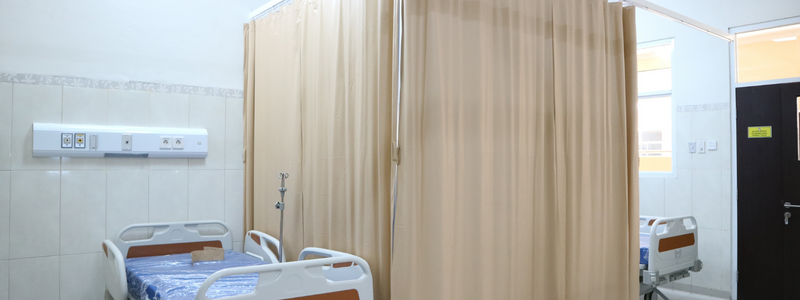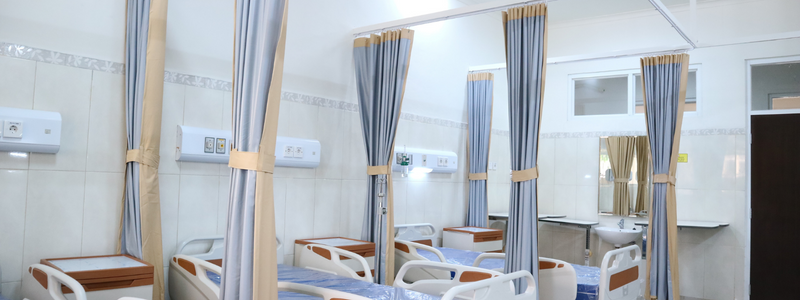When it comes to maintaining a safe and hygienic environment in a hospital setting, infection control measures are of utmost importance. While much attention is given to sanitizing surfaces, equipment, and medical instruments, hospital curtains are often overlooked as a potential source of infection.
Privacy curtains are a ubiquitous feature in hospital rooms, and they are frequently used by medical staff and patients alike. However, these curtains can also become contaminated with potentially harmful pathogens, including blood and stool from infected patients. Without regular cleaning, they can harbor bacteria and viruses that pose a risk to both patients and medical professionals.
In this article, we will explore the importance of regular cleaning and disinfection of hospital curtains, and how it can help to prevent the spread of infectious diseases. We will also examine the recommended cleaning guidelines and best practices for ensuring that hospital curtains remain clean and safe for use in medical facilities.

Hospital Cubicle Curtains
Hospitals have a critical responsibility to maintain a high level of cleanliness to prevent the spread of infections among patients, visitors, and staff. However, cleaning hospital cubicle curtains can be a challenging task that requires specialized skills and equipment. That’s why many hospitals outsource their cleaning services to healthcare agencies to ensure that the curtains are regularly and effectively cleaned.
Outsourcing offers several benefits, including convenience and efficiency. Hospitals often lack sufficient space and resources to perform the cleaning in-house, and outsourcing can provide a practical solution to this problem. Healthcare agencies also have the expertise and experience to ensure that the curtains are thoroughly cleaned and free from harmful contaminants.
By outsourcing cleaning services, hospitals can focus on their core responsibilities, such as providing high-quality patient care. Moreover, healthcare agencies already have an understanding of the standard patient care processes, which means less time spent figuring things out.
In conclusion, outsourcing cleaning services for hospital cubicle curtains is a practical solution that offers several benefits, including convenience, efficiency, and expertise. It ensures that the curtains are regularly and effectively cleaned, which helps maintain a high level of cleanliness and prevent the spread of infections in healthcare facilities.

Different Kinds of Hospital Curtains
Hospital curtains are an essential part of any healthcare facility. They provide privacy for patients and help to maintain hygiene standards by separating different areas within the hospital. There are several types of hospital curtains, each with its own unique features and benefits. In this article, we’ll take a look at some of the different kinds of hospital curtains available and what makes them special.
- Disposable Curtains: Disposable curtains are a popular option in hospitals as they can be easily replaced and disposed of, which reduces the risk of infection. They are made of non-woven materials and are designed to be used for short periods, typically up to six weeks.
- Anti-Microbial Curtains: Anti-microbial curtains are specially designed to prevent the spread of infections. They are made of materials that have been treated with anti-microbial agents to reduce the growth of bacteria and other microorganisms. These curtains are ideal for use in high-risk areas such as operating theaters and intensive care units.
- Privacy Curtains: Privacy curtains are commonly used in hospital rooms to provide patients with a sense of privacy. They are typically made of heavy-duty materials such as vinyl or polyester and can be easily cleaned and maintained.
- Blackout Curtains: Blackout curtains are designed to block out light and create a dark environment for patients who need to rest or recover. They are often used in intensive care units or in patient rooms where patients need to sleep during the day.
- Cubicle Curtains: Cubicle curtains are used to divide larger hospital rooms into smaller, private spaces. They are typically made of polyester or a polyester blend and are easy to clean and maintain. These curtains can be used to create temporary rooms in emergency departments or in other areas where privacy is needed.
When to Start Curtain Sanitation
Hospital curtains, also known as cubicle curtains or privacy curtains, are an essential feature of every medical facility. They provide patients with privacy, separate care areas, and can help reduce the spread of infection. However, hospital curtains can also become a breeding ground for harmful bacteria and pathogens if not properly cleaned and sanitized. So, when should hospitals start their curtain sanitation process?
The short answer is that curtains should be cleaned and sanitized regularly, but the exact frequency will depend on several factors. The Centers for Disease Control and Prevention (CDC) recommends that hospitals clean and disinfect curtains “when they are visibly soiled, after any spill of blood or body fluids, and on a regular basis, such as daily or weekly, depending on the risk of contamination.”
It’s important to note that “the risk of contamination” will vary depending on the type of patient care being provided. For example, curtains in operating rooms and emergency departments may require more frequent cleaning and disinfection than those in a general ward. In addition, hospitals should consider factors such as the prevalence of infections in the community and the specific needs of their patient population when determining their curtain sanitation schedule.
Hospitals should also keep in mind that even if curtains don’t appear visibly soiled, they can still harbor bacteria and viruses. Recent studies have shown that hospital curtains can be contaminated with drug-resistant bacteria, such as methicillin-resistant Staphylococcus aureus (MRSA), even when they appear clean. For this reason, some hospitals have implemented more frequent curtain cleaning and disinfection protocols to reduce the risk of healthcare-associated infections.
For Frequency, check out the following cases to follow:
- Isolation cases: Be sure to replace the curtains and dispose of any soiled drapes.
- Visibly stained curtains: Replace the entire set of curtains and dispose of any soiled material.
- Ongoing cases: It is crucial to discuss your caseload with the launderer and follow their recommendations. Establishing a regular schedule will ensure a smooth process for both parties and reduce any anxiety about potential issues.
The cubicle curtain is a great choice for privacy, but it might be difficult to clean and change.
The cubicle curtain is an essential component in maintaining patient privacy, but it can be a challenge to keep them clean and fresh. The curtains often come into contact with healthcare workers, patients, and their visitors, making them susceptible to contamination. Therefore, regular cleaning and changing of these curtains are critical to maintaining a clean and safe environment for patients, staff, and visitors. However, this process can be difficult and time-consuming, requiring proper planning and execution to ensure efficient and effective curtain maintenance.
The following are some of the reasons why:
- Hospitals are not the cleanest places. They’re often full of dirt and germs, which can make it difficult for doctors to work in their robes without causing public health hazards (such as exposing patients).
- With the lack of documentation for cubicle curtain changes, many organisations are left in a state where they have no idea what to do.
- The inventory room is bursting at the seams with too many items.
- Patient rooms should be cleaned and disinfected on a regular basis in order to maintain the highest standards of patient care. Laundering is tedious work, which slows down room turnaround time significantly as it takes longer for staff members to handle dirty linens or equipment during cleanings. The importance lies not only with maintaining hygiene but also in protecting against pathogens that may carry disease-causing agents such as bacteria and viruses
- Incur additional expenses to have your curtain system installed.

Your Comprehensive Hospital Cleaning Program
Healthcare laundry is an essential part of any healthcare facility. It’s imperative that the right launderer partner be found for your business, as they will have processes meeting or exceeding requirements and standards, among others, to ensure protection from infection prevention shortcuts which can lead back to patient care errors like recall notices on product liability grounds if not handled correctly by a reputable company with sound policies in place about contaminated clothing being returned upright after use, so it does not pose potential risks during future wash cycles.
Safety First Cleaning Solution
Changing a hospital privacy curtain should be safe and simple, but it usually involves a ladder. Look for a provider who partners with you and handles the change. Certain providers offer simplified systems with panels that can be snapped on and off from a mesh hanging from the railing without needing a ladder.
Ask For The Cleaning Solution Techs
An issue with changing curtains is that it’s difficult to keep track. Your best bet would be asking your launderer how they record which one was changed and when, as well as what documentation will be given, so you know everything has been done correctly! Ideally, this process should leverage technology, so there is not too much human error involved.
Make Sure The Cleaning Solution is A Full-Service
Your staff can focus on much more important tasks when it’s easy to manage curtain panels. Make sure the vendor handles delivering clean, properly sanitised hospital privacy curtains for you – they’ll also help keep track of inventory and change them at scheduled times, so their appearance never disrupts your workflow again!
Don’t Use Capital Expenditure for Curtains
It is estimated that purchasing new curtains could require a capital budget of up to six figures. However, renting from the company will avoid this cost and also allow you more time for other important aspects of running your business!
Find A Simplified Curtain Solution
Some vendor partners offer programs that allow for similar-sized panels to be attached at different heights so you can have an easier time when it comes time to remove or replace them.
Conclusion
When it comes down to having your hospital curtains laundered, be sure that you first evaluate the needs of a facility. There’s regulatory freedom when deciding what makes sense for you and there shouldn’t ever be any hesitation in doing whatever is needed as long as patients’ comfort & security remains top priority!
Whether you’re a large or small facility, it’s important to be mindful of your patient’s needs when deciding how best affordably provide cleanliness. Regulatory freedom allows for different solutions according to the specific requirements at hand, so there are no set guidelines unless one wants them!
When considering the need for privacy curtains in your facility, it is important that you first evaluate what will work best. There are regulatory freedoms when choosing this option so long as patients’ comfort and security remain top priorities The decision on whether or not laundered linens should be used ultimately lies with each institution – but make sure they meet all necessary standards before putting them out!


